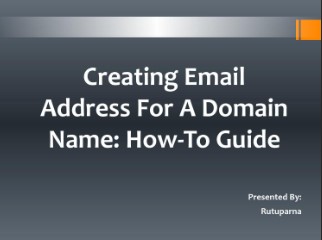Purchase Domain Dame For Website
A domain name is your website’s unique address on the internet, an identifier that people type into their browser to visit your site.
It’s more than just a technical necessity; it’s a crucial element of your online identity. A well-chosen domain name not only enhances your brand’s visibility but also lends an air of professionalism and credibility.
How Domain Names Work
Domain names function by translating human-friendly names into IP addresses that computers use to identify each other on the network.
When you enter a domain name into your browser, a request is sent to a global network of servers that form the Domain Name System (DNS). These servers then direct the request to the appropriate web server, where the desired website is hosted.
Types of Domain Names
Top-Level Domains (TLDs)
Top-level domains, or TLDs, are the suffixes at the end of domain names, such as .com, .org, and .net. These are the most common and recognized domains, providing a level of trust and familiarity to users.
Country Code Top-Level Domains (ccTLDs)
Country Code Top-Level Domains (ccTLDs) are domain extensions specific to a particular country, like .uk for the United Kingdom or .de for Germany. These can be beneficial for businesses targeting a specific geographic audience.
New Generic Top-Level Domains (TLDs)
New Generic Top-Level Domains (TLDs) have expanded the domain name landscape with extensions like .guru, .shop, and .tech. These offer creative branding opportunities and can make a domain name more descriptive and memorable.
Brainstorming Domain Ideas
Creative Techniques for Name Generation
When brainstorming domain names, think about what makes your brand unique. Combine relevant keywords, use synonyms, and consider phrases that resonate with your target audience. Tools like thesauruses and rhyming dictionaries can spark creative combinations.
Utilizing Domain Name Generators
Domain name generators can be invaluable, especially when you need inspiration or are hitting a creative block. These tools combine keywords and generate a list of potential domain names, helping you discover options you might not have considered.
Key Considerations for Selection
Brand Consistency and Memorability
Your domain name should be consistent with your brand and easy to remember. Avoid complex spellings and aim for a name that is intuitive and straightforward, making it easier for users to find you online.
Keyword Relevance and SEO Impact
Incorporating relevant keywords into your domain name can boost your search engine optimization (SEO). It helps search engines understand what your website is about, potentially improving your site’s ranking for related searches.
Length and Simplicity
Shorter domain names are generally more effective. They are easier to type, less prone to errors, and more memorable. Strive for a balance between brevity and clarity to create a strong, lasting impression.
Checking Domain Availability
Tools for Availability Checks
There are numerous online tools to check domain availability, such as WHOIS databases and registrar websites. These tools allow you to see if your desired domain name is taken and suggest alternatives if it is unavailable.
Researching Potential Conflicts
Before finalizing your domain name, conduct a thorough search to ensure it doesn’t conflict with existing trademarks or established brands. This can help avoid legal issues and ensure that your domain name is unique and distinguishable.
What is a Domain Registrar?
Definition and Role
A domain registrar is a company accredited to sell and manage domain names. They provide the interface through which you can search for available domains, register them, and manage their settings.
How to Choose a Reliable Registrar
Selecting a reliable registrar involves considering factors like reputation, user interface, customer support, and additional services like privacy protection and email hosting.
Popular Domain Registrars
Overview of Leading Providers
Leading domain registrars like GoDaddy, Namecheap, and Google Domains offer a range of features, competitive pricing, and strong customer support. Each has its strengths, catering to different needs and preferences.
Comparing Features and Pricing
When comparing registrars, look at their pricing structures, including any hidden fees. Evaluate the features they offer, such as DNS management, domain forwarding, and privacy protection, to ensure they meet your requirements.
Factors to Consider
Security Features and Privacy Protection
Security features like two-factor authentication (2FA) and WHOIS privacy protection are crucial. They help protect your domain from unauthorized changes and keep your personal information private.
Renewal Rates and Hidden Fees
Be aware of renewal rates, which can be significantly higher than the initial registration fee. Check for any hidden fees associated with transferring domains, making changes, or other services.
Customer Support and User Experience
Reliable customer support is essential, especially if you encounter issues with your domain. Look for registrars that offer 24/7 support and have a reputation for resolving issues promptly and effectively.
Step-by-Step Registration Process
Selecting a Domain Registrar
Choose a domain registrar that aligns with your needs and budget. Consider their reputation, user reviews, and the additional services they offer.
Performing a Domain Search
Use the registrar’s search tool to check the availability of your desired domain name. If it’s taken, the tool will often suggest alternatives.
Completing the Registration Form
Fill out the necessary registration forms with accurate information. This typically includes your contact details, which will be recorded in the WHOIS database unless you opt for privacy protection.
Understanding Terms and Conditions
Read and understand the registrar’s terms and conditions before completing your purchase. This includes renewal policies, fees, and any restrictions on your domain name usage.
Domain Privacy Protection
Importance of WHOIS Privacy
WHOIS privacy protection hides your personal contact information from the public WHOIS database. This can protect you from spam, scams, and potential identity theft.
How to Enable Privacy Protection
Most registrars offer privacy protection as an optional service during the registration process. Opt for this service to keep your information private and secure.
Domain Settings and Configuration
Accessing Domain Management Tools
Log in to your registrar’s control panel to access domain management tools. These tools allow you to configure settings, manage DNS records, and renew your domain.
Setting Up DNS Records
DNS records direct internet traffic to your website. Configure these records correctly to ensure your domain points to the correct web server and email services.
Domain Renewal and Expiration
Renewal Reminders and Procedures
Set up renewal reminders to avoid your domain expiring. Many registrars offer auto-renewal options to ensure continuous ownership of your domain.
Consequences of Letting a Domain Expire
If your domain expires, it can be purchased by someone else, potentially causing you to lose your online presence. Renew your domain promptly to avoid this risk.
Transferring Your Domain
Reasons for Domain Transfer
You might need to transfer your domain to another registrar for better pricing, features, or customer service. Ensure your domain is unlocked and obtain an authorization code for the transfer.
Step-by-Step Transfer Guide
Follow the registrar’s instructions for transferring your domain. This typically involves initiating the transfer with the new registrar and confirming it with the old one.
Enhancing Brand Identity
Using Your Domain for Email Addresses
Create professional email addresses using your domain name. This enhances your brand’s credibility and keeps your communications consistent.
Integrating Domain with Social Media
Use your domain name consistently across social media platforms to strengthen your brand identity and make it easier for customers to find you.
Improving SEO with Your Domain
Best Practices for Domain SEO
Choose a domain name with relevant keywords, ensure it’s easy to read and avoid hyphens and numbers. These practices can improve your site’s SEO and attract more visitors.
Utilizing Subdomains and Subdirectories
Use subdomains and subdirectories to organize your website’s content effectively. This can enhance your site’s navigation and SEO performance.
Future-Proofing Your Domain
Adapting to Market Changes
Stay informed about changes in the domain name market and adapt your strategy accordingly. This includes keeping an eye on new TLDs and industry trends.
Monitoring Trends and Updates
Regularly review your domain’s performance and make updates as needed. This ensures your domain continues to support your brand’s growth and evolution.
Conclusion: The Impact of a Well-Chosen Domain
Recap of Key Points
A well-chosen domain name is crucial for establishing a strong online presence. From understanding domain types to choosing the right registrar and optimizing for SEO, each step plays a vital role.
Encouraging Action
Start your domain search today and take the first step towards building a successful online presence. With careful planning and consideration, you can secure a domain name that supports your brand’s growth.
Looking Forward
Stay ahead in the digital landscape by continuously managing and optimizing your domain. Leverage your domain for long-term success and keep evolving with the changing market dynamics.





